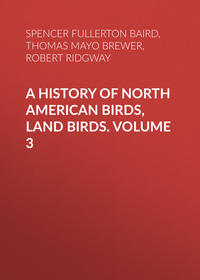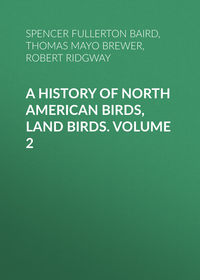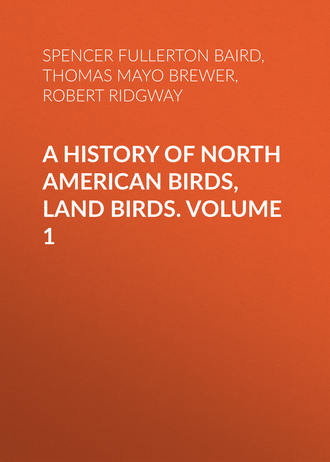 полная версия
полная версияA History of North American Birds, Land Birds. Volume 1
Habits. This interesting species, one of the liveliest and most animated of its family, belongs to the northern and eastern sections of North America. It is found in the eastern and northern portions of Maine, and probably also in the northern parts of New York, Vermont, and New Hampshire. In the heavily wooded mountain-valley of Errol, in the latter State, Mr. Maynard met with this bird in the latter part of October, in company with the common atricapillus. In the same month he also obtained two birds in Albany, in the northwestern corner of Maine. A single specimen was taken at Concord, Massachusetts, October 29, by Mr. William Brewster.
Near Calais it is resident, but not common. It is more abundant in the islands of the Bay of Fundy, where it takes the place, almost exclusively, of the atricapillus. The writer first met with these lively little wood-sprites in 1850, in the thick swampy woods which cover one of the small islands near Grand Menan. Their general appearance as they flitted through the woods, or rustled restlessly among the tangled débris of decaying trees and underbrush with which the forest was choked, was not unlike that of our common Black-Cap. Yet there was an indescribable something both in their cries and in their manners that at once suggested a difference of species. To my ear their cries were sharper, clearer, and a trifle harsher. There was none of that resonant jingle so full of charm in the Chickadee. Their notes, too, were more articulate, more like distinct words, and were brought out at certain times with an emphasis the effect of which was very striking. Beginning with tschā-dēē, the dēē-dēē-dēē was reiterated with an almost incessant volubility.
It seemed to be a more retiring bird, never frequenting the houses, but keeping closely to thick and retired woods. Yet it is not a timid species, but seemed entirely unmindful of our presence, or, when mindful of it, to resent it as an impropriety, rather than to fear it as a danger. They apparently had nests or young at the time of my visit, though I could not detect their locality. One pair became at last so annoyed at my prolonged presence as to manifest their uneasiness by keeping within a few feet of my head, following me wherever I went, and without ceasing from their close surveillance until I finally left their grove and emerged into the open country. All the time they brought out the cry of dēē-dēē with a clear, ringing emphasis that was almost startling.
A few days later, being at Halifax, Mr. Andrew Downes, the naturalist, took me to the nest of these birds in a small grove in the vicinity of that city. The nest was in a small beech-tree, and had been cut through the living wood. The excavation, which was not more than two feet from the ground, was about ten inches in depth, was in a horizontal position only about two inches, where it turned abruptly downward, and from a width of an inch and a half assumed a width of three, and a depth of seven or eight inches. This was warmly lined with feathers and soft fur. The nest contained young birds. These particulars we only ascertained when we had laid bare the excavation by a sharp hatchet. Though disappointed in our search for eggs, yet we witnessed a very touching manifestation of devotion on the part of the parents, and of neighborly solicitude in various other inmates of the grove, which was at once most interesting and a scene long to be remembered.
With all the self-sacrificing devotion of the Black-Cap, these birds displayed a boldness and an aggressive intrepidity that at once commanded our respect and admiration. I never witnessed anything quite equal to it. They flew at our faces, assailed our arms as we wielded the invading hatchet, and it was difficult not to do them even unintentional injury without abandoning our purpose. Before we could examine the nest they had entered, and had to be again and again removed. As soon as we were satisfied that the nest of this heroic pair did not contain what we sought, we left them, and turned to look with equal admiration upon the indignant assembly of feathered remonstrants by which we were surrounded. The neighboring trees swarmed with a variety of birds, several of which we had never before seen in their summer homes. There were the Red-Poll Warbler, the Black and Yellow Warbler, and many others, all earnestly and eloquently crying out shame upon our proceedings.
Dr. Bryant, in his Notes on the Birds of Yarmouth, N. S., etc., mentions finding quite a number of this species on Big Mud Island, near that place. A pair of these birds with their young were seen by him near Yarmouth on the 3d of July. Their habits seemed to him identical with those of the Black-Cap. The young were fully grown and could fly with ease, yet their parents were so solicitous about their safety that he could almost catch them with his hand. Their notes appeared to him similar to those of our common species, but sharper and more filing, and can be readily imitated by repeating, with one’s front teeth shut together, the syllables tzēē-dēē-dēē-dēē.
Mr. Audubon found a nest of this Titmouse in Labrador. It was built in a decayed stump about three feet from the ground, was purse-shaped, eight inches in depth, two in diameter, and its sides an inch thick. It was entirely composed of the finest fur of various quadrupeds, chiefly of the northern hare, and all so thickly and ingeniously matted throughout as to seem as if felted by the hand of man. It was wider at the bottom than at the top. The birds vehemently assailed the party.
Mr. Ross, in notes communicated to the late Mr. Kennicott, mentions that specimens of this species were shot at Fort Simpson, October 13, in company with P. septentrionalis, and others were afterwards seen towards the mountains. The notes he describes as harsher than those of the septentrionalis. The Smithsonian museum contains specimens from Fort Yukon and Great Slave Lake, besides the localities already referred to. Mr. Dall found it the commonest Titmouse at Nulato, abundant in the winter, but not present in the spring.
The eggs of this species measure .56 by .47 of an inch, are of a rounded oval shape, and with a white ground are somewhat sparingly marked with a few reddish-brown spots. These are usually grouped in a ring around the larger end.
Genus PSALTRIPARUS, BonapPsaltriparus, Bonap. Comptes Rendus, XXXI, 1850, 478. (Type, P. melanotis.)
Ægithaliscus, Cabanis, Museum Heineanum, 1851, 90. (Type, Parus erythrocephalus.)
Psaltria, Cassin, Ill. N. Am. Birds, 1853, 19.
Gen. Char. Size very small and slender. Bill very small, short, compressed, and with its upper outline much curved for the terminal half. Upper mandible much deeper than under. Tail long, slender, much graduated; much longer than the wings; the feathers very narrow. Tarsi considerably longer than the middle toe. No black on the crown or throat. Eyes white in some specimens, brown in others. Nest purse-shaped; eggs unspotted, white.
No bird of this genus belongs to the eastern portion of the United States. The three species may be defined as follows:—
A. Head striped with black on the sides.
P. melanotis. The stripes passing under the eye and uniting on the occiput. Hab. Eastern Mexico
B. No stripes on the head.
P. minimus. Back ashy; crown light brown. Hab. Pacific Province of United States … var. minimus.
Back and crown uniform ashy. Hab. Middle Province and southern Rocky Mountains of United States … var. plumbeus.
Psaltriparus melanotis, BonapBLACK-EARED BUSH-TITMOUSEParus melanotis, Hartlaub, Rev. Zoöl. 1844, 216. Pœcile melanotis, Bp. Consp. 1850, 230. Ægithaliscus melanotis, Cab. Mus. Hein. I, 1850, 1851, 90. Psaltria melanotis, Westermann, Bijd. Dierk. 1851, 16, plate. Psaltriparus melanotis, Bonap. C. R. XXXVIII, 1854.—Sclater, P. Z. S. 1858, 299.—Ib. 1864, 172 (City Mex.).—Salvin, Ibis, 1866, 190 (Guatemala).—Baird, Birds N. Am. 1858, 386, pl. liii, fig. 3; Review, 84. Psaltriparus personatus, Bonap. C. R. XXXI, Sept. 1850, 478.
Sp. Char. A black patch on each cheek, nearly meeting behind. Crown and edges of the wing and tail ash-gray; rest of upper parts yellowish-brown, lighter on the rump. Beneath whitish; anal region tinged with yellowish-brown. Length about 4 inches; wing, 1.90; tail, 2.30.
Hab. Eastern Mexico; south to Guatemala; Oaxaca (high region), Sclater. East Humboldt Mountains, Nevada? Ridgway.
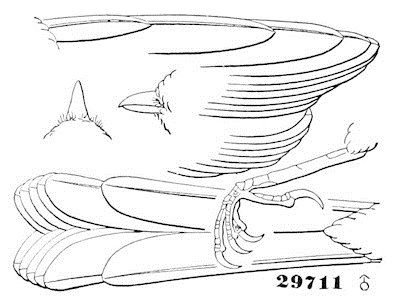
Psaltriparus minimus.
29711 ♂
Habits. In regard to the specific peculiarities and the distinct individual habits of the members of this pretty little species, little is at present known. Its mode of nesting has not been observed, and no mention is made, by those who have met with it, of its peculiarities of song, nor have we any information in regard to any of its habits. Its geographical distribution, so far as ascertained, is from the south side of the valley of the Rio Grande of Mexico to Guatemala, and there is no reliable evidence of its crossing the United States boundary line, unless Mr. Ridgway is correct in his assurance that he saw it in the East Humboldt Mountains of Nevada, near Fort Ruby. It was first described from Guatemalan specimens. Mr. O. Salvin (Ibis, 1866, p. 190) states that on more than one occasion he observed what he believed to be this species, in the pine-woods of the mountains near Solola, and above the lake of Atitlan.
Psaltriparus minimus, var. minimus, BonapLEAST BUSH-TITMOUSEParus minimus, Townsend, J. A. N. Sc. VII, ii, 1837, 190.—Aud. Orn. Biog. IV, 1838, 382, pl. ccclxxxii, figs. 5, 6.—Ib. Birds Am. II, 1841, 160, pl. cxxx. Pœcile minima, Bon. Consp. 1850, 230. Psaltria minima, Cassin, Illust. 1853, 20. Psaltriparus minimus, Bon. C. R. XXXVIII, 1854, 62.—Baird, Birds N. Am. 1858, 397; Review, 84.—Cooper & Suckley, P. R. R. Rep. XII, ii, 1859, 195.—Cooper, Birds Cal. 1, 48.
Sp. Char. Tail long, feathers graduated. Above rather dark olivaceous-cinereous; top and sides of head smoky-brown. Beneath pale whitish-brown, darker on the sides. Length about 4 inches; wing, 1.90; tail, 2.25.
Hab. Pacific coast of United States.
There is quite an appreciable difference between specimens of this species from Washington Territory and California; the latter are smaller, the under parts paler. In the series before us, however, we see no grounds for specific distinction.
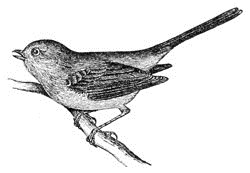
Psaltriparus minimus.
Habits. This interesting little species was first added to our fauna by the indefatigable Mr. Townsend in 1837. It is abundant throughout the Pacific coast from Fort Steilacoom to Fort Tejon. Dr. Gambel found it exceedingly abundant both in the Rocky Mountains and throughout California. During the winter the otherwise cheerless woods were alive with the busy and noisy troops of these restless and industrious birds, gleaning their scanty fare in company with the Reguli, in every possible position and manner, from bush and tree. He describes their anxious solicitous search for food as quite curious. They kept up a continual twittering, and so intent were they in their employment that they appeared to lose sight of all danger, and it was by no means unusual to be so surrounded by a flock as almost to render it possible to catch them in the hand.
Dr. Cooper found this species abundant in Washington Territory, but never met with it north of the Columbia River. Dr. Suckley says it is quite common at Fort Steilacoom. He could not, however, detect any difference in its habits from those of other species of this family. He saw none in Washington Territory during the winter, and presumes they all migrate to the South, though the rufescens and the occidentalis are found there throughout the winter. Townsend, however, speaks of it as a constant resident about the Columbia River, hopping around among the bushes, hanging from the twigs in the manner of other Titmice, twittering all the while with a rapid enunciation resembling the words thshish tshist-tsee-twee.
Mr. Nuttall first observed their arrival on the banks of the Wahlamet River about the middle of May. They were very industriously engaged in quest of insects, and were by no means shy, but kept always in the low bushes in the skirts of the woods. On one occasion the male bird was so solicitous in regard to the safety of the nest as to attract him to the place where, suspended from a low bush, about four feet from the ground, hung their curious home. It was formed like a long purse, with a round hole for entrance near the top, and made of moss, down, lint of plants, and lined with feathers. The eggs were six in number, pure white, and already far gone toward hatching. In the following June, in a dark wood near Fort Vancouver, he saw a flock of about twelve, which, by imitating their chirping, he was able to call around him, and which kept up an incessant and querulous chirping.
A nest of this bird presented by Mr. Nuttall to Audubon was cylindrical in form, nine inches in length and three and a half in diameter. It was suspended from the fork of a small twig, and was composed externally of hypnum, lichens, and fibrous roots so interwoven as to present a smooth surface, with a few stems of grasses and feathers intermingled. The aperture was at the top, and did not exceed seven eighths of an inch in diameter. The diameter of the internal passage for two thirds of its length was two inches. This was lined with the cottony down of willows and a vast quantity of soft feathers. The eggs were nine in number, pure white, .56 of an inch by .44 in their measurement.
Dr. Cooper found them throughout the year near San Francisco. He found one of their nests at San Diego as early as the first of March. The nest is so large, compared with the size of the birds, as to suggest the idea that the flock unite to build it. He gives the measurements as eight inches in length and three in diameter, outside; the cavity five inches long, one and a half in diameter. It was cylindrical, and suspended by one end from a low branch.
When one of these birds is killed, Dr. Cooper says that the others come round it with great show of anxiety, and call plaintively until they find it will not follow them, becoming so fearless as almost to allow of their being taken by the hand.
Psaltriparus minimus, var. plumbeus, BairdLEAD-COLORED BUSH-TITMOUSEPsaltria plumbea, Baird, Pr. A. N. S. VII, June, 1854, 118 (Little Colorado). Psaltriparus plumbeus, Baird, Birds N. Am. 1858, 398, pl. xxxiii, fig. 2; Review, 84.—Sclater, Catal. 1861, 398, No. 77.—Cooper, Birds Cal. 1, 49.
Sp. Char. Tail long, feathers graduated. Above rather light olivaceous-cinereous. Top of head rather clearer; forehead, chin, and sides of head, pale smoky-brown. Beneath brownish-white, scarcely darker on the sides. Length about 4.20 inches; wing, 2.15; tail, 2.50.
Hab. Southern Rocky Mountain region of United States, from mountains of West Arizona to Green River, Wyoming; west to Carson City, Nevada (Ridgway).
This variety is very similar to the Psaltriparus minimus of the west coast, which it represents in the Rocky Mountain region. It is, however, appreciably larger, the wings and tail proportionally longer. The top of the head is plumbeous, uniform with the back, instead of smoky-brown. The back is a paler ash, the under parts darker.
Habits. Of the history of this variety but little is known. It is found in the southern portion of the Rocky Mountain regions, within the United States, in Arizona and New Mexico. The extent of its area of distribution remains to be ascertained. Dr. Kennerly met with it on Little Colorado River, where he observed it among the scattered bushes along the banks of the river, occurring in large flocks. These passed rapidly from place to place, uttering their short, quick notes. He afterward met with them along the head waters of Bill Williams Fork, inhabiting the tops of the cotton-wood trees. When attracted to them by their notes, they could only be seen after a very careful search. He obtained no knowledge as to their mode of nesting, and no information, so far as we are aware, has been obtained in regard to their eggs. It may, however, be safely conjectured that they are white, and hardly distinguishable from those of the minimus. Dr. Coues found them common near Fort Whipple, Arizona.
Mr. Ridgway met with this bird in especial abundance among the cañons of West Humboldt Mountains in September. He found it also in all suitable places westward to the very base of the Sierra Nevada Mountains. It was met with principally in the thick brushwood bordering the streams, in ever-restless companies, continually twittering as they flew from bush to bush, in single rows. Mr. Ridgway describes these birds as remarkably active in their movements. If unmolested, they were exceedingly unsuspicious and familiar. During November he found them inhabiting the cedars, always associating in scattered flocks.
Genus AURIPARUS, BairdAuriparus, Baird, Rev. Am. Birds, 1864, 85. (Type, Ægithalus flaviceps, Sund.)
Gen. Char. Form sylvicoline. Bill conical, nearly straight, and very acute; the commissure very slightly and gently curved. Nostrils concealed by decumbent bristles. Wings long, little rounded; the first quill half the second; third, fourth, and fifth quills nearly equal, and longest. Tail slightly graduated. Lateral toes equal, the anterior united at the extreme base. Hind toe small, about equal to the lateral. Tarsus but little longer than the middle toe.
This genus is closely allied to Paroides of Europe, as shown in Birds of North America (p. 399), though sufficiently different. It is much more sylvicoline in appearance than the other American Paridæ.
Auriparus flaviceps, BairdYELLOW-HEADED BUSH-TITMOUSE; VERDINÆgithalus flaviceps, Sundevall, Ofversigt af Vet. Ak. Förh. VII, v, 1850, 129. Psaltria flaviceps, Scl. P. Z. S. XXIV, March, 1856, 37. Psaltriparus flaviceps, Scl. Catal. Am. Birds, 1861, 13, No. 79. Paroides flaviceps, Baird, Birds N. Am. 1858, 400, pl. liii, fig. 2. Auriparus flaviceps, Baird, Review, 1864, 85.—Cooper, Birds Cal. 1, 51. Conirostrum ornatum, Lawrence, Ann. N. Y. Lyc. May, 1851, 113, pl. v, fig. 1 (Texas).
Sp. Char. Above cinereous; head, all round, yellow; lesser wing-coverts chestnut; beneath brownish-white. Length, 4.50 inches; wing, 2.16; tail, 2.35.
Hab. Valleys of the Rio Grande and Colorado; Cape St. Lucas.
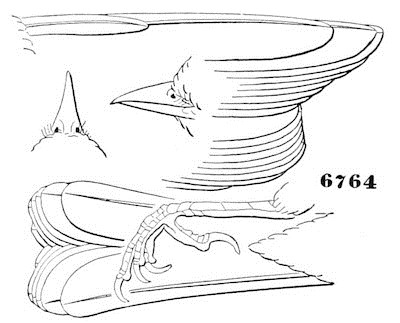
Auriparus flaviceps.
6764
Habits. This new and interesting little species was first added to our fauna by Mr. Lawrence in 1851, only a year after its first description as a bird of Mexico. Notwithstanding the abundance in which it has been in certain localities, less has been developed in regard to its habits and specific characteristics than we seem to have had a right to anticipate.
It was found in Western Texas, in Mexico, in the lower valleys of New Mexico and Arizona, and is very abundant at Cape St. Lucas. Of the eighteen species of birds found by Mr. John Xantus breeding in the last-named locality, this one was regarded as the most abundant. In a letter from that gentleman, written in August, 1859, he mentioned that he had collected over one hundred eggs of this species, during that season, in the immediate vicinity of Cape St. Lucas.
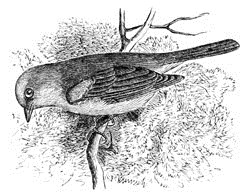
Auriparus flaviceps.
Dr. Heermann, in his report on the birds observed in Lieutenant Williamson’s explorations, states that he first discovered this species in Southern California, at the terminus of the Mohave River. Owing to their extreme wildness, he was not able to obtain any specimens. In searching for their food, he states that they often remained suspended with their backs downward, after the manner of the Titmice. He found their nests quite abundant, though from the lateness of the season few of the birds were remaining, in the neighborhood of Fort Yuma. Dr. Heermann describes their nests as spherical, formed of twigs, and having the entrance on one side. The interior was lined with down and feathers, and contained usually from four to six eggs. These he describes as having, when fresh, a ground-color of pale blue, dashed all over with small black spots.
Dr. Kennerly, in his Report on the Birds of the Mexican Boundary Survey, states that he met with this species in the vicinity of the Rio Grande. They were very wild, flew rapidly, and to quite a distance before they alighted. They seemed to frequent the low mezquite-bushes on the hillsides.
Mr. Xantus found this species, when he first arrived at San Lucas, on the 4th of April, with young birds already fully fledged, although others were still breeding and continued to breed until the middle of July. Two fifths of all the eggs he collected that season, he writes, were of this species. This may, however, have been in part owing to the conspicuous prominence of their nests, as well as to their abundance. Xantus found the nest in various positions. In one instance it was suspended from a leafless branch not three feet from the ground, with its entrance nearly to the ground. In another instance it was on an acacia twenty feet from the ground. For the most part they are hung from low acacia-trees, on the extreme outer branches. In all cases the entrance to the nest was from the lower end, or towards the ground.
Dr. J. G. Cooper, in his History of the Birds of California, speaks of finding a large number of this beautiful little bird during the whole winter frequenting the thickets of algarobia and other shrubs, and with habits intermediate between those of Titmice and Warblers, corresponding with their intermediate form. Their song resembles that of the Chickadee, and they also uttered a loud cry, as they sat on high twigs, with a triple lisping note resembling tzee-tee-tee. Dr. Cooper found a pair building on the 10th of March. They first formed a wall, nearly spherical in outline, of the thorny twigs of the algarobia, in which tree the nest was usually built. They then lined it with softer twigs, leaves, the down of plants, and feathers. They covered the outside with thorns, until it became a mass as large as a man’s head, or nine inches by five and a half on the outside. The cavity is four and a half inches by two, with an opening on one side just large enough for the bird to enter. On the 27th of March, Dr. Cooper found the first nest containing eggs. These were in all instances four in number, pale blue, with numerous small brown spots, chiefly near the larger end, though some had very few spots and were paler. Their size he gives as .60 by .44 of an inch. In one nest, which he closely observed, the eggs were hatched after about ten days’ incubation, and in two weeks more the young were ready to leave their nest.
Subfamily SITTINÆ
The characters of the Sittinæ are expressed with sufficient detail on page 86. The section is represented in America by a single genus, confined mainly to the northern portion.
Genus SITTA, LinnæusSitta, Linnæus, Syst. Nat. 1735. (Agassiz.)

Sitta carolinensis.
1761 ♀
Gen. Char. Bill subulate, acutely pointed, compressed, about as long as the head; culmen and commissure nearly straight; gonys convex and ascending; nostrils covered by a tuft of bristles directed forward. Tarsi stout, scutellate, about equal to the middle toe, much shorter than the hinder, the claw of which is half the total length. Outer lateral toe much longer than inner, and nearly equal to the middle. Tail very short, broad, and nearly even; the feathers soft and truncate. Wings reaching nearly to the end of the tail, long and acute, the first primary one third of (or less) the third, or longest. Iris brown. Nest in holes of trees. Eggs white, spotted with reddish.




